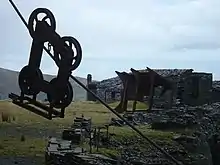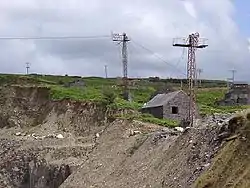Blondin (quarry equipment)
Blondins were a type of material ropeway employed in open pits in the slate quarries in Wales to transport wagons loads of rock between locations. They were named after the famous tightrope walker Charles Blondin.[2]


History
The first known use of Blondins in the quarry industry was at Penrhyn Quarry where they were installed by 1913.[2] Penrhyn quarry was based around a single large pit over 400 feet deep, worked as a series of terraces. A variety of means were used to transport slate from the terraces to the mills where the rock was processed. The quarry already had an extensive internal narrow gauge railway system in place and many terraces were connected via inclines. Blondins were developed to connect more remote terraces directly to the mills - they were distinguished by the fact that rock was transported on the ropeways in railway wagons slung from cradles. The ropeways ran horizontally or nearly horizontally until the cradle hit a stop, at which point the wagons were automatically lowered to ground level where they were moved by rail to the point of loading or unloading.[2]
Other nearby quarries also adopted Blondins, notably those in the Nantlle Valley.[2]
References
- Hatherill, Slate Quarry Album, Blondins –
Recollections of a crane inspector, John Hobbs, 1974, pp. 183-184
 A photograph of a Blondin at Pen yr Orsedd quarry.
A photograph of a Blondin at Pen yr Orsedd quarry. - Boyd, James I.C. On the Welsh Narrow Gauge. Bradford Barton.
Bibliography
| Wikimedia Commons has media related to Blondins. |
- Stuart Baker. "5: Blondins". In Gordon & Ann Hatherill (ed.). Slate Quarry Album (Second ed.). RCL Publications. pp. 38–43. ISBN 978-0-9538763-8-9.
